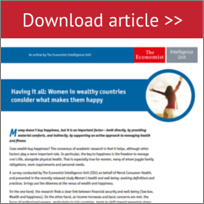When it comes to defining well-being, where a woman stands on the issue can depend on where she sits; specifically, where she sits geographically. Our recent survey, conducted on behalf of Merck Consumer Health, and presented in the recently released study Women’s health and well-being: evolving definitions and practices, finds that definitions of well-being can vary a great deal based on geography and level of economic development.
Against this backdrop, the United Nations is taking aim at the problems interfering with women’s well-being. For example, it targeted high maternal and infant mortality rates in its Millennium Development Goals (MDGs—see Box 1) for the years 2000-15. This year, in its recently released Sustainable Development Goals (SDGs—see Box 2) for 2016-30, the UN aimed even higher, setting ambitious goals for achieving worldwide gender equality and empowerment—that is, self-determination in decision-making—for women and girls.






